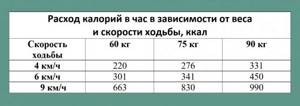The number of steps per day is the norm of 10 thousand: truth or myth?
Even children know about the 10 thousand steps that need to be taken for health every day. However, not everyone knows where exactly this figure came from. It turns out that today we are lengthening our daily routes in an effort to reach the cherished 10,000 thanks to the creativity of Japanese marketers of the 60s of the last century.
Against the backdrop of the Olympic Games held in Tokyo in 1964, a wave of popularization of sports and healthy lifestyles arose here. And at the same time, an advertising campaign for the first pedometers was launched for people who care about their health. These Japanese devices were called “10,000 steps” because the hieroglyph for this number is similar to the figure of a walking man. That’s why marketers began to promote the idea that exactly this number of steps, equal to approximately 7 km, is the norm for steps per day.
The most interesting thing is that the myth that originated in marketing was subsequently confirmed by the World Health Organization. Today, 6–10 thousand are listed in WHO recommendations as the lower threshold of normal human physical activity. Let us emphasize that this is not the norm as such, but only its lower limit.
It should be borne in mind that WHO considers walking as one of the options for physical activity. That is, it is not necessary to go through exactly that much - you can do less if on this day, for example, you also ride a bike, or swim, or do aerobics, dancing...
In general, health institutes urge adults to devote at least half an hour of moderate-intensity physical activity per day, in addition to the required 5-6 thousand steps - a level slightly above a sedentary lifestyle. In steps, this will be 3–4 thousand steps (plus the five or six already mentioned), with the condition that:
1) their intensity is average or higher (100 or more steps per minute);
2) the duration of each walk is at least 10 minutes.
If you are concerned about the question of how many steps you should take per day, it is also worth familiarizing yourself with the relationship between the number of steps and lifestyle (data from WHO).
HOW FAST OR AT WHAT SPEED YOU SHOULD WALK TO BETTER HEALTH
- To keep your muscles toned and enjoy enjoying the nature around you, you can take a leisurely walk at a speed of 60 steps per minute. You will get a good mood and get rid of minor ailments with a leisurely walk.
- To improve health and improve the functioning of your body, you need to increase your speed to 80 steps per minute.
- At a speed of 120 steps per minute, increased metabolic processes are launched and you spend more calories. This pace is recommended by nutritionists for weight loss and for people with increased weight.
By taking a stopwatch and counting the steps taken in a minute, you will find out your speed and decide what pace you should take next - speed up or you can go slower.
It is convenient to use a pedometer, which displays the average speed of your walking.
The norm of steps for a person per day: what scientists say
The Japanese scientist Yoshiro Hatano was the first to justify the 10,000-step norm per day. He found that the average Japanese person walks only three and a half to five thousand steps every day. At the same time, there is a widespread increase in the recommended calorie intake by 300–400 kcal per day. Hatano's calculation showed that 10,000 steps helps burn these extra calories, which maintains normal weight and also strengthens the cardiovascular system.
However, there are other opinions on how many steps you need to take per day. Thus, Professor Greg Hager from the University of Maryland in 2017 criticized the fact that 10 thousand is a single standard of steps for everyone. "I'm sure these (pedometer) apps are causing problems," Hager said. And he referred to the fact that for many physically weakened people, the desire to follow this norm causes significant harm to health.
A study by Harvard scientists published in 2021 in JAMA Internal Medicine also undermines the stereotype about the absolute benefits of 10,000 steps. I-Min Lee and colleagues examined the association of daily steps with mortality in older women. They observed the condition of 16,741 women for four years, whose average age was 72 years.
It turned out that 4,400 steps per day significantly reduced mortality rates, compared with 2,700 steps. Even better results in increasing life expectancy were obtained by increasing steps to 7500. However, a larger number of steps no longer had any benefits for the subjects, overloading their body. Thus, the norm of steps per day for women over 70 is unlikely to exceed 7.5 thousand steps.

An experiment by medical journalist Mosley and Professor Copeland from Sheffield Hallam University also refuted the dogma of an unconditional 10,000 steps per day. The researchers looked at the health outcomes of two groups of people. The first group took daily walks, completing 10,000 thousand steps in about a couple of hours. The subjects from the second group went out 3 times a day for short but intense walks of 10 minutes, walking on average about 3 thousand steps per day.
The most interesting thing is that it was in the second group that the health indicators turned out to be better. Mosley and Copeland concluded that short but vigorous (moderate intensity) walks or other activities are healthier than 10,000 steps at a leisurely pace.
Adviсe
Walking will be useful and enjoyable if you use the following recommendations:
- Keep your posture. A straight back while walking forms the core muscles and enhances the effect on the cardiovascular system. The hunched position of the body puts pressure on the internal organs.
- Breathe only through your nose. Sometimes, during heavy exertion (climbing a slope), it is allowed to exhale through the mouth. It is important that breathing does not falter, but is active, then the body will receive more oxygen, which means it will increase blood flow and nutrition of cells. Inhalation through the mouth allows infections to enter the respiratory tract, cools them, and exposes them to stress.
- Dress properly. Rain is a reason to choose waterproof shoes, snow and frost - warm clothes, a sunny hot day - a white umbrella, sunscreen, breathable fabrics. It is important not to allow external circumstances to disrupt the regularity of your walks.
- Make a playlist with pleasant, upbeat music. It will entertain you and help you keep the rhythm.

Benefits of Walking
While the number of steps per day for a person is controversial in the scientific community, the beneficial effects of regular walking are beyond doubt. Walking more than 5–6 thousand steps contributes to:
- production of endorphins and improved mood;
- saturation of blood with oxygen and improvement of respiration of cells and tissues;
- activation of blood circulation and metabolic processes, improvement of blood supply and nutrition of tissues and organs;
- reducing blood sugar and cholesterol levels;
- burning fat and maintaining normal weight;
- increasing stress resistance and performance;
- strengthening the immune system;
- strengthening the osteoarticular apparatus and muscles;
- prevention of diabetes mellitus, cardiac diseases, stroke and heart attack, osteoporosis and other age-related diseases.
It is important to understand that the effects of walking appear depending on the time, conditions and intensity of the walk (see the figure below, data from the National Health League, given in the “Recommendations for organizing a health route “10,000 steps”).

The benefits of walking
In addition to losing weight, walking has health benefits:
- Metabolism improves;
- The oxygen content in the blood increases;
- Bones, muscles, joints are strengthened;
- There is an increase in body tone, a decrease in cholesterol and blood sugar;
- The pressure returns to normal;
- The risk of colds and heart diseases is reduced;
- Due to the production of endorphin (the hormone of happiness), mood improves;
- The functioning of all organs improves, the ability to work increases;
- Resistance to stress is developed.
How many kilometers to walk for health? Young people do not have to limit themselves. To keep your body in good shape, 10 thousand steps are enough. For older people - 8,000 steps.
How many minutes will be the norm for mature people? This is 30 minutes at a good pace. But, as always, you need to rely on your well-being. But we shouldn’t overpower ourselves, because we don’t need records, but health.
Today there is a special application on a smartphone or fitness bracelets that will count steps, show distance, and monitor the progress of training. Applications keep track of all steps and not only in training. So aim for at least 10,000 steps on your step counter to lose weight.
It is especially useful for a pregnant woman to walk. Walking will help improve blood circulation and strengthen the musculoskeletal system. The main thing is not to overwork!
Norm of steps per day for women and men, young and old
So, here are the average recommendations for different genders, age groups and people with health conditions.
- Children over 5 years of age are highly physically active. For the development of the body, a load of 10–15 thousand steps is quite normal.
- Teenagers 11–18 years old are also highly active. The range of normal steps per day for them expands from 10 to 20 thousand steps.
- adults aged 18–50 can afford long walks, but you should not lower your daily physical activity below 12 thousand steps.
- Older people 50–70 years old can target 8–10 thousand steps.
- People over 70 years old should try to walk at least 4.5–6 thousand steps.
Please note that these calculations assume that you do not engage in any other sports, but work or relax mainly in a sitting position. Naturally, on a day when you spent an hour or two in the gym, the number of steps can be safely reduced by 2-3 times.
Regarding the norms of steps per day for men and women, some recommendations do not separate them, focusing solely on age. Sometimes in the literature you can find slightly lower standards for women after 50: they are recommended to walk one to two thousand steps less per day than men.

Possible health problems are of much greater importance in determining the useful number of steps per day. For example, acute arthritis, arthrosis, acute respiratory viral infections with fever, and recent surgery inevitably impose restrictions on physical activity. And here you cannot do without consulting your doctor. Also, you should not immediately try to walk the recommended maximum if you have not been particularly fond of walking before. Introducing to it, as well as to sports, should be based on the rule of the three “Ps”: gradualism, phasing, consistency. Build up your walking capabilities slowly but surely, giving your body time to adapt to increasing loads.
How to calculate the number of steps per day for weight loss
Many people start walking the recommended 10,000 steps just to lose weight. But a month passes, then another - and there is no expected result. Most likely, the reason is a calorie imbalance. That is, even despite the efforts made, a person spends more than he consumes.
In this case, it is necessary to adjust the diet. In particular, it is worth replacing high-calorie foods with healthy low-calorie ones (how to do this is described here). You can use a calorie calculator - this is another useful health app that you can find on the Internet and install on your smartphone.
When counting calories spent while walking, you need to understand that walking can be different: fast, slow, with obstacles, uphill... Accordingly, energy consumption will also be different. Calorie consumption also depends on the body weight of the person walking: a fat person spends more calories (see table).

Following these steps will help you burn more calories and body fat while walking.
- Choose a route with uneven terrain: uphill climbs will double your efforts and improve your results. Go for a walk along the sand or snow-covered streets - combine romance with intense weight loss.
- Increase the intensity of your step from time to time: try to cover the same distance in a shorter period of time.
- Change your pace every five minutes - this interval approach can burn up to 20% more calories than steady walking.
How to force yourself to move every day?
Now that we understand the benefits of walking, it is important to figure out how to force yourself to walk.
- Buy a pedometer. He will constantly push you to take extra steps.
- Set a starting amount per day.
- Add 500 steps.
- Plan some activities during your hike.
- Hang out with others who want to lose weight.
- Use a calorie consumption calculator, which will also become an incentive for brisk walks.
- In heavy rain, you can “do laps” in a large shopping center, because the important thing is to move!
How to improve fat burning while walking
The natural vitamin and mineral complex for safe weight loss Kilo Light from the Fitness&Life line will help speed up the weight loss process. This is exactly the drug that involves an active approach to weight loss, enhancing the fat-burning effect of physical activity.
In addition, Kilo Light:
- provides vivacity and energy without extra calories;
- blocks excess appetite;
- promotes muscle growth.
Kilo Light has a generally healing effect. And if most weight loss products literally rob the body, this drug, on the contrary, provides it with all the necessary nutrients: vitamins, minerals, amino acids, etc. That is why the use of Kilo Light together with an increase in any type of physical activity and diet correction will help you lose weight faster at a pace and without stress to the body.
Literature
- Each municipality has a health route. Recommendations for organizing a health route “10,000 steps” / National Health League. https://www.med.cap.ru/UserFiles/main/sitemap/doc/610d0321-f625-48d6-9ec8-ea5e71d7ffe3/rekomendacii-po-organizacii-marshruta.pdf
- Tudor-Locke C., Pangrazi RP, Hatano Y., Kang M.. Revisiting “How Many Steps Are Enough?” // Medicine & Science in Sports & Exercise. 2008. No. 40 (7): 537–543.
- I-Min Lee, Eric J. Shiroma, Masamitsu Kamada, et al. // JAMA Intern Med. Published online. May 29, 2021.No. 179 (8):1105–1112.
- Gortsev G. How to become slim. Secrets of losing weight. – M.: T8 RUGRAM, 2021.
Author: Doroshina V. A.
Reviewer: reflexologist Kurus A. N.











